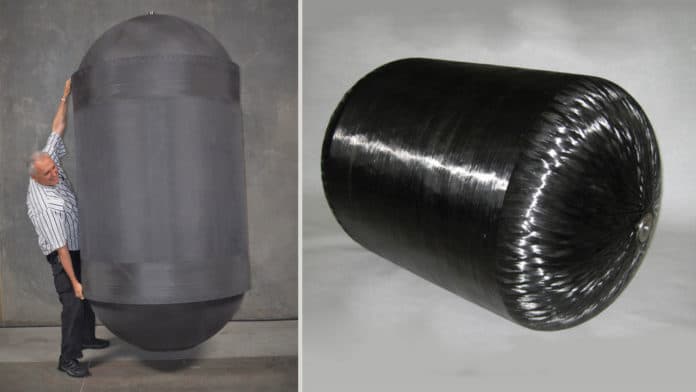A California-based HyPoint is developing zero carbon-emission turbo air-cooled hydrogen fuel cell systems for aviation and urban air mobility. NASA award-winning hydrogen fuel cell pioneer has now announced a partnership with a hydrogen tank maker Gloyer-Taylor Laboratories (GTL), to integrate GTL’s advanced carbon-composite “BHL Cryotank” liquid hydrogen fuel tanks with HyPoint’s aeroplane fuel cell system that could dramatically increase range.
BHL Cryotanks have demonstrated a 75% mass reduction compared to existing state-of-the-art aerospace cryotanks (metal or composite), enabling hydrogen aircraft and eVTOL makers to store as much as 10 times more liquid hydrogen fuel without adding mass. As a result, aircraft can travel longer distances without refueling.
GTL has fabricated and tested multiple BHL Cryotanks at a range of scales and has been demonstrated to be leak-tight even after repeated cryo-thermal pressure cycles. This technology has achieved TRL 5+ and is compatible with a variety of cryogenic propellants, including liquid oxygen, liquid methane, and liquid hydrogen.
The BHL Cryotank pictured here measures 2.4 meters long with a 1.2-meter diameter and weighs 12 kilograms (roughly 26 pounds). With the addition of a skirt and vacuum dewar shell, the total system weight is 67 kilograms. This particular tank system can hold over 150 kilograms of liquid hydrogen, giving it a hydrogen storage ratio of at least 50% (the weight of stored hydrogen fuel relative to total system weight), which is as much as 10 times greater than current state-of-the-art fuel tanks. HyPoint estimated that an aircraft equipped with GTL dewar tank technology could achieve as much as four times the range of a conventional aircraft using aviation fuel, cutting aircraft operating costs by an estimated 50% on a dollar-per-passenger-mile basis.
Sergei Shubenkov, Co-founder and Head of R&D at HyPoint, further illustrated their reason behind working with GTL by comparison with an already hydrogen-fuelled plane. Based on an internal analysis of a De Havilland Canada Dash 8 Q300, which seats 50 to 56 passengers, the standard PW123B engine would typically support a range of 1,558 km. By implementing HyPoint’s system and a standard liquid hydrogen tank, the same aircraft could achieve five hours of flight time or a max range of 2,640 km.
With GTL’s tank, it could fly for 8.5 hours or a max range of 4,488 km, indicating that the aircraft could fly three times further with zero emissions by using HyPoint and GTL compared with conventional aviation fuel. “That’s the difference between this plane going from New York to Chicago with high carbon emissions versus New York to San Francisco with zero carbon emissions,” Shubenkov said.
“Reducing weight is the most important factor for enabling longer-distance air travel with fewer stops to refuel,” said Dr. Alex Ivanenko, founder and CEO of HyPoint. “Our hydrogen fuel cell system offers better specific power performance compared with any alternative available today, opening the door to short-haul zero-emission hydrogen flight and urban air mobility. This partnership with GTL goes even further by offering aircraft and eVTOL makers a liquid hydrogen tank that is stronger and lighter than anything else on the market, thereby significantly increasing fuel capacity. By utilizing this new fuel tank technology, longer-haul aircraft may be able to utilize hydrogen for the first time, while eVTOL makers can effectively multiply their flight range and operational time. We’re excited to be working with GTL to offer superior alternative power sources and accelerate the adoption of zero-emission hydrogen across the aviation industry.”
